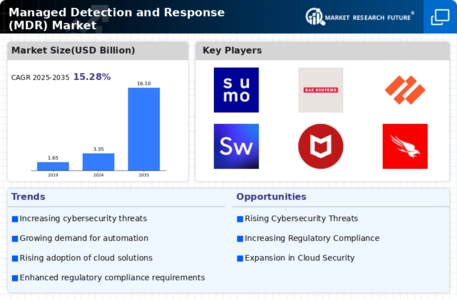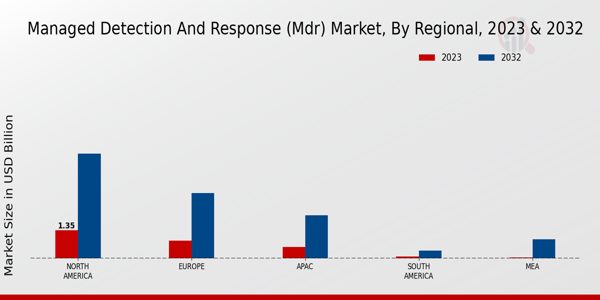Market Growth Chart
Increasing Cybersecurity Threats
The Global Managed Detection and Response (MDR) Market Industry is experiencing heightened demand due to the escalating frequency and sophistication of cyber threats. Organizations are increasingly targeted by ransomware, phishing attacks, and advanced persistent threats, necessitating robust security measures. In 2024, the market is projected to reach 3.35 USD Billion, reflecting a growing recognition of the need for proactive threat detection and response capabilities. As cybercriminals evolve their tactics, businesses are compelled to invest in MDR services to safeguard sensitive data and maintain operational integrity. This trend underscores the critical role of MDR in contemporary cybersecurity strategies.
Adoption of Cloud-Based Solutions
The Global Managed Detection and Response (MDR) Market Industry is witnessing a surge in the adoption of cloud-based solutions, driven by the increasing reliance on cloud infrastructure. As organizations migrate their operations to the cloud, they face unique security challenges that traditional security measures may not adequately address. MDR services offer tailored solutions that enhance visibility and threat detection in cloud environments. This shift is likely to contribute to the projected CAGR of 15.31% from 2025 to 2035, as businesses seek to leverage the scalability and flexibility of cloud technologies while ensuring robust security measures are in place.
Regulatory Compliance Requirements
The Global Managed Detection and Response (MDR) Market Industry is significantly influenced by stringent regulatory compliance requirements across various sectors. Organizations are mandated to adhere to regulations such as GDPR, HIPAA, and PCI DSS, which impose rigorous data protection standards. Failure to comply can result in substantial fines and reputational damage. Consequently, businesses are increasingly turning to MDR solutions to ensure compliance and mitigate risks associated with data breaches. The anticipated growth of the market to 16.1 USD Billion by 2035 illustrates the importance of MDR in helping organizations navigate complex regulatory landscapes while maintaining a secure environment.
Growing Awareness of Cybersecurity Importance
The Global Managed Detection and Response (MDR) Market Industry is benefiting from a growing awareness of the importance of cybersecurity among organizations of all sizes. As high-profile data breaches and cyber incidents make headlines, businesses are becoming more proactive in their approach to security. This heightened awareness is driving investments in MDR services, as organizations seek to enhance their security posture and protect sensitive information. The increasing recognition of cybersecurity as a critical business function is likely to propel the market forward, fostering a culture of security that prioritizes proactive threat detection and response.
Integration of Artificial Intelligence and Machine Learning
The Global Managed Detection and Response (MDR) Market Industry is being transformed by the integration of artificial intelligence and machine learning technologies. These advanced tools enable organizations to analyze vast amounts of data in real-time, identifying patterns and anomalies that may indicate security threats. By automating threat detection and response processes, MDR services enhance operational efficiency and reduce response times. As organizations increasingly recognize the value of AI-driven security solutions, the demand for MDR services is expected to rise, further solidifying its position in the cybersecurity landscape. This technological advancement is likely to shape the future of the industry.

















